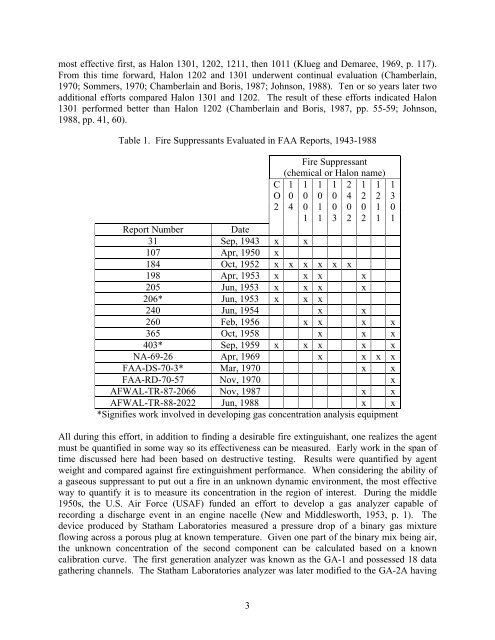FAA Engine Compartment Halon Replacement Project Background ...
FAA Engine Compartment Halon Replacement Project Background ...
FAA Engine Compartment Halon Replacement Project Background ...
You also want an ePaper? Increase the reach of your titles
YUMPU automatically turns print PDFs into web optimized ePapers that Google loves.
most effective first, as <strong>Halon</strong> 1301, 1202, 1211, then 1011 (Klueg and Demaree, 1969, p. 117).<br />
From this time forward, <strong>Halon</strong> 1202 and 1301 underwent continual evaluation (Chamberlain,<br />
1970; Sommers, 1970; Chamberlain and Boris, 1987; Johnson, 1988). Ten or so years later two<br />
additional efforts compared <strong>Halon</strong> 1301 and 1202. The result of these efforts indicated <strong>Halon</strong><br />
1301 performed better than <strong>Halon</strong> 1202 (Chamberlain and Boris, 1987, pp. 55-59; Johnson,<br />
1988, pp. 41, 60).<br />
Table 1. Fire Suppressants Evaluated in <strong>FAA</strong> Reports, 1943-1988<br />
Fire Suppressant<br />
(chemical or <strong>Halon</strong> name)<br />
C 1 1 1 1 2 1 1 1<br />
O 0 0 0 0 4 2 2 3<br />
2 4 0 1 0 0 0 1 0<br />
1 1 3 2 2 1 1<br />
Report Number Date<br />
31 Sep, 1943 x x<br />
107 Apr, 1950 x<br />
184 Oct, 1952 x x x x x x<br />
198 Apr, 1953 x x x x<br />
205 Jun, 1953 x x x x<br />
206* Jun, 1953 x x x<br />
240 Jun, 1954 x x<br />
260 Feb, 1956 x x x x<br />
365 Oct, 1958 x x x<br />
403* Sep, 1959 x x x x x<br />
NA-69-26 Apr, 1969 x x x x<br />
<strong>FAA</strong>-DS-70-3* Mar, 1970 x x<br />
<strong>FAA</strong>-RD-70-57 Nov, 1970 x<br />
AFWAL-TR-87-2066 Nov, 1987 x x<br />
AFWAL-TR-88-2022 Jun, 1988 x x<br />
*Signifies work involved in developing gas concentration analysis equipment<br />
All during this effort, in addition to finding a desirable fire extinguishant, one realizes the agent<br />
must be quantified in some way so its effectiveness can be measured. Early work in the span of<br />
time discussed here had been based on destructive testing. Results were quantified by agent<br />
weight and compared against fire extinguishment performance. When considering the ability of<br />
a gaseous suppressant to put out a fire in an unknown dynamic environment, the most effective<br />
way to quantify it is to measure its concentration in the region of interest. During the middle<br />
1950s, the U.S. Air Force (USAF) funded an effort to develop a gas analyzer capable of<br />
recording a discharge event in an engine nacelle (New and Middlesworth, 1953, p. 1). The<br />
device produced by Statham Laboratories measured a pressure drop of a binary gas mixture<br />
flowing across a porous plug at known temperature. Given one part of the binary mix being air,<br />
the unknown concentration of the second component can be calculated based on a known<br />
calibration curve. The first generation analyzer was known as the GA-1 and possessed 18 data<br />
gathering channels. The Statham Laboratories analyzer was later modified to the GA-2A having<br />
3
















